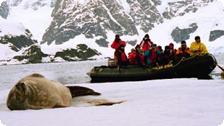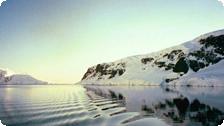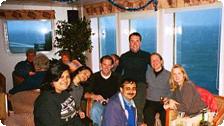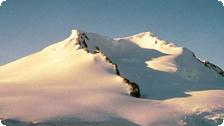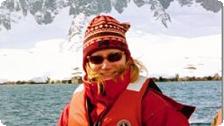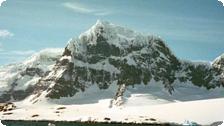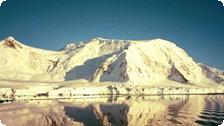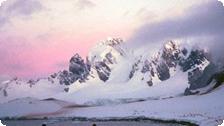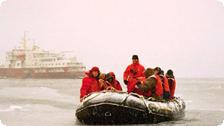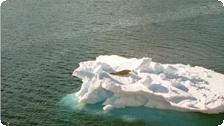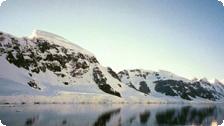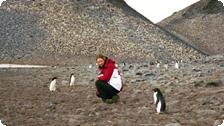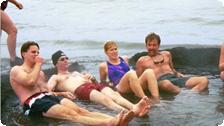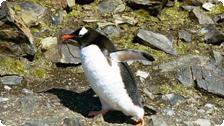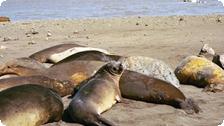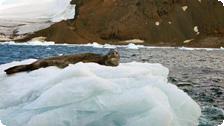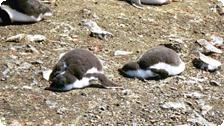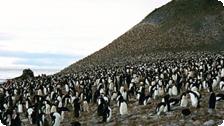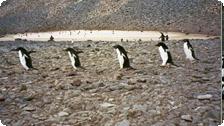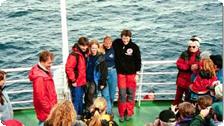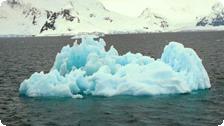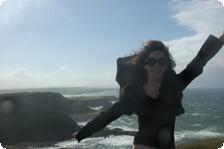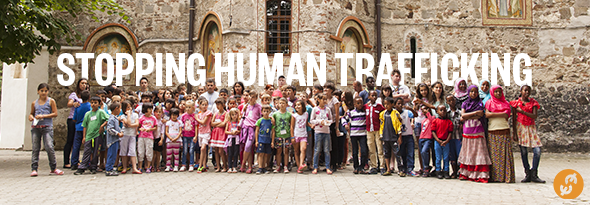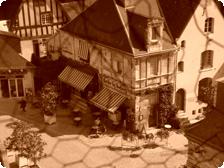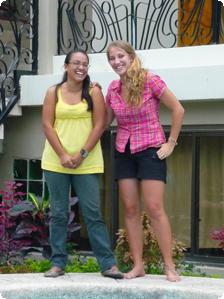Inspiration: Antarctica: Chillin’ at the Bottom of the World
by Cheryl Dalhe
In December of 2001, writer Cheryl Dahle visited the frozen continent with two polar explorers, Ann Bancroft and Liv Arnesen, whose story she was
researching and writing. This is the story of her trip. The book about the explorers, No Horizon is So Far, is available from Penguin Paperback (www.bancroftarnesenexplore.com).
* * * *
My trip began in Buenos Aires. Yes, that would be the place where the economy was collapsing and people were rioting in the streets days before I was due to arrive. Yet another case of my impeccably bad timing and lousy luck with international travel. Past adventures in this category have included lost luggage unsuccessfully trailing me for weeks across multiple continents and climates while I toughed out a British winter with no coat and a South African summer in wool slacks; sleazy Dominican men chasing me down the street in Santiago yelling, “Let’s have sex, baybee”; and getting caught in the middle of a fist fight between French tourists at Charles de Gaulle airport at the ticket counter. Let’s put it this way: Terry Waite—the guy who was kidnapped during a trip to Beirut and held hostage for five years—once told me that he thought I had awful luck traveling. So it only made sense that I was bound for Argentina during one of the least stable and most dangerous periods in its recent history.
I actually did briefly consider wimping out on the trip. But then I thought about trying to explain to my co-authors Ann and Liv—women who had skied across Antarctica pulling 250-pound sleds in sub-zero temperatures (and who were also booked as lecturers on this trip)—that I was afraid of a little tear gas. What a weenie. I’d get fired as their writer for sure. For luck, my friend Tony gave me a metal cross blessed by some monks or priests or somebody like that. He is the same Catholic friend who sent the icon of Jesus (which I dubbed Traveling Jesus) with me on the trip to South Africa. I don’t take religious trinkets very seriously, but I don’t think Tony does, either. What he really likes about being Catholic is the lore, power struggles, and intrigue: “It’s just like being in the Mob, except without the danger part.” So I take his stuff with me because it reminds me that someone is sympathetic to my neurosis.
As it turned out, my fears were unfounded and my timing was mercifully good. The looting was done by the time I showed up in town, and on the way back, I was there a day before the peso was devalued. The country went through about five or six presidents during that time. As our tour guide in Buenos Aires said after picking us up at the airport, “It is sooo embarrassing.” All told, I was in Buenos Aires one day on the way to Antarctica, and a half-day on the way back. Tony joked that the folks in Buenos Aires had considered making me president on my way back through, but I was going to be in town too long.
Even in that brief amount of time and given the tumultuous circumstances of the visit, I was very taken with the city. We managed to cram in an afternoon tour of the city, which included visits to some of the more colorful and historic neighborhoods, including La Boca, where the tango first became popular, and Recoleta, the old-money section of town with the huge stone mansions. “We,” at this point refers to myself and Laural, the woman the travel agency had connected me with to share a room in Buenos Aires. I think both of us had feared that the other would be a seventy-year-old woman. So we were both relieved to find that we were the same age, and both from Michigan (!). By the time we caught the flight from Buenos Aires to Ushuaia (pronounced either Oose-why-uh or You-shwhy-uh, depending on which local you believe), we were longtime friends in tourist years. We bonded over Argentine pizza and the local drink, capariños—made from liquor from fermented sugar cane.
All Aboard: December 28
The boat in Ushuaia was a workhorse vessel: An 86.5-meter-long icebreaker, it had a double hull, the outer shell made of steel several inches thick. The hull was painted brick red, and a blue painting of a polar bear graced the sides of its uppermost deck. We would be spending eleven days together in our new floating home. We walked up the gangway clutching our carry-on bags and got our cabin assignments from Nigel Bishop, the hotel manager. Nigel had a Las Vegas nightclub host look about him, with a grin straight out of the British Book of Smiles. His was to be the Austin-Powers-meets-Dick-Clark voice that greeted us every morning over the ship’s intercom: “Good mmmornin’, ladies and gentlemen. The time…is seven a.m., and breakfast…is being suhrrrrved.”
I was assigned to a room of my own with two twin berths. The cabin was small, but cozy. I had two large, rectangular windows looking out on the sea. There were drawers under the beds for storage, small cabinets for hanging clothes. I noticed that all of the doors and closets snapped shut pretty snugly, but it didn’t occur to me why that was necessary—yet.
There were sixty-nine passengers on board, ages ranging from five to eighty-six. There were a fair number of elderly passengers, several of whom were surprisingly game for adventure and challenge. Only a couple of cranks in the bunch. We represented seventeen countries. The owner of the ship, Martin Karlson, a Norwegian shipping magnate, was on board with his extended family, including a few aunts, grandmas, cousins—his kin accounted for all of the kids. The trip was a bit pricey for children too young to remember most of it. There were about ten of us who were in our late twenties/early thirties and wound up hanging out together for most of the trip. Some of that gang who’ll play recurring roles in this missive:
Tommy—Graphic designer from New York with a gentle voice and flawless comedic timing. Also the “gear head” of the group. Brought a 3-D camera, iPod and other cool toys.
Laural—Deceptively quiet woman from Michigan; the kind of apparent innocent with a secretly raucous sense of humor.
Stuart—Smart-ass, gregarious Brit with perfect deadpan delivery. He’s in the tourist biz; plans and leads tours for a company in England, so he’s been all over the world and has the tales to prove it.
Mark—Tall, sarcastic law school student in Palo Alto with a great sense of adventure. Kept us giggling with his running commentary on everything from food to passengers. He went backpacking in Patagonia after the cruise.
Right after we left the pier, we had a brief lifeboat drill, which amounted to most of us standing around with chunks of orange foam strapped to our chests while we waited for the weakest links among us to figure out the difference between “port” and “starboard.” I managed to alienate most of the elderly passengers at my assembly station by using my rescue whistle to accompany an improvised rap version of “Camptown Races.” (Camptown LAY-dees, sing dis song. DOO-da. DOO-da.) Hey, I was bored. I did manage to get a grin out of Miles, a quirky, sweet Anatarcticaphile from England. He owns more than thirty books about the continent and has applied for work multiple times with the British Geologic Society, which runs most of the Brit research projects here. Unfortunately, they don’t seem to have much use for a social worker, so he had decided to get to the continent on his own dime.
That night after dinner, the ship’s doctor stood up in the observation lounge at the introductory briefing and reminded us that that night we would be entering the Drake Passage, renowned for some of the roughest seas in the world—mainly because it’s where the Atlantic, Pacific, and Southern oceans converge. Dennis, our expedition leader, told us to not leave anything on top of our desks or nightstands. One of the expedition staff in the audience warned those within earshot to try to wrap themselves up in the bedclothes so they WOULDN’T GET THROWN OUT OF BED IN THE MIDDLE OF THE NIGHT if we hit a storm. I’m thinking, “Hey, where was THAT line in the brochure?!”
The Drake
By the time I turned in at around one a.m., (the last time I would see anything resembling darkness for the next eleven days) the ship was already starting to roll in the six -to-eight-meter swells. The waves were perpendicular to our course, so the rocking was a regular side-to-side motion. Once in my bed, placed with the headboard against the outer wall, I became a human teeter-totter. It took me some time to drift off to sleep.
At seven a.m. my alarm let out a muffled squawk from inside my nightstand drawer. I leapt out of bed and was promptly thrown toward the wall by a huge wave. I grabbed on to the foot of the bed just in time to avoid a concussion. I staggered the four steps to the bathroom and pulled the heavy door open as the boat pitched in the same direction. But as the door caught the wave’s momentum, it kept going and yanked me right along with it. I let go of the handle and stepped through the doorway—just as the boat rocked the other direction. The door came flying back at me and whacked me in the hip and elbow. And that was just the first ten seconds of my morning. It got worse. Taking a pee meant bracing at least one hand against the sink or the wall so I didn’t slide off the seat, though I remember being grateful that at least I wasn’t a guy having to execute that maneuver standing up.
I was having such success coping with the waves that I decided to take a shower and deal with them while standing on wet tile. Brilliant. It was bad enough that the ship was rocking, the tile was slippery and I couldn’t let go of the shower bar for fear of ending my life by conking my head on the commode. I also had to “chase” the water as it dodged right and left with the boat’s movement. Meanwhile, the water kept sloshing over the drain instead of going down it, so I was standing in several inches of suds. I pulled back the curtain to grab a towel, the boat pitched, and three inched of water went rushing over the tile lip of the shower floor and flooded the bathroom. Yay. Time to swab the deck, matey.
An hour after my alarm had gone off, I found myself dressed and combed, ready for the day, with three new bruises forming on my legs and completely exhausted. The ship’s P.A. intoned the two bells signaling an announcement, and Dennis, the expedition leader, greeted us: “Good morning! Welcome to what we call the ‘Drake Lake,’ ladies and gentlemen. We’re having an exceptionally *easy* passage this time around, so we’re hoping our good luck holds and the smooth conditions continue for the next two days.” I couldn’t decide which news was worse, that this was considered smooth, or that we had two straight days of it to look forward to.
The good news is that I didn’t get seasick (thanks to medication), and I got used to the rolling motion of the boat fairly soon—once I figured out the secret to finding my sea-legs: Getting around was more about aim than balance. If you’re headed for a doorway, shoot for a point slightly to the left or right of the door, depending on which way the boat is rolling. By the time you get there, the waves will have pushed you just shy of or just beyond your target, so you’ll make it through the door, no worries. By the afternoon of day one, I was getting pretty good at the physics of overcompensation. Not so for several of the elderly passengers on board, one of whom stumbled into a chair and required twenty stitches.
In fact, I actually grew to like the rocking motion of the ship. Sitting in the observation lounge, a room with rows of chairs and windows on three sides, I watched the horizon dip up and down in a regular rhythm. As we rolled to one side and then the other, I closed my eyes and pictured the ship perched on the ocean’s belly, rising and falling as the water breathed. I stopped fighting the motion and gave myself over to the swaying. I felt strangely protected and safe. That night, pitching to and fro in my bed, I dreamed of being rocked to sleep by a giant, gentle unseen hand.
January 30: The Expedition Staff
We traveled two full days without any land in sight. During that time we heard lectures from the expedition staff on various elements of the Antarctic. The team of experts included the following:
Terrence “Scobie” Pye. Our resident historian. He’d spent more than twenty summers in Antarctica, and seventeen or so winters. He originally worked as a carpenter for a British research station, but eventually earned a masters degree in Antarctic history. His thesis was on rats in Antarctica. He looked like a bloke sent from Central Casting to be a grizzled, old sailor: weathered face, gray hair and long beard, blue-collar British accent (he referred to “me beer” and “me pants.”) We never did find out where his nickname, “Scobie,” came from.
Ingrid Vissner. Marine biologist. Incredibly knowledgeable and a true zealot about whales. She does research with Orca whales in New Zealand, where she’s from. She’s one of the few whale researchers in the world who studies whales by swimming with them without a cage. She has rescued a couple of whales that beached themselves in New Zealand. One of them, named Digit, seeks her out when she’s in the water. During lunch one day, Mark proposed to our group a TV show about Ingrid and Digit, called “Ingrid’s Friend.”
Scene: Ingrid sunbathing in her boat when a wave splashes across her
Ingrid: Well, hallo mate! Good to see ya, Digit.
Digit turns a few circles and whacks his flippers on the water
Ingrid: What that? Someone’s in trouble? There’s a man about two meters tall wearing red swim trunks drowning in the bay? Take me to him, boy.
Boat speeds off after Digit’s fin with “Baywatch” music in the background.
I think we had a whole season for that show worked out before dessert.
Jim Collinson. Geologist. Very Serious Man, except when studying his rocks. I caught him a few times when we were on landings breaking open rocks by flinging them at boulders, sending shards flying everywhere. Dude, you are so gonna take out somebody’s eye doing that!
After dinner we watched documentaries on Antarctica. These proved to be the source of several recurring punch lines on the boat. The first night, we saw a wonderful film about rounding Cape Horn, narrated by a sailor who was on the ship. He had shot the footage while on board in his mid-twenties, in what must have been the 1920s or 30s. (I am a little rusty on cinematic history, so I couldn’t tell for sure when these kinds of cameras would’ve been available.) Instead of the typical scripted, solemn, excruciatingly informative PBS-style of narration, this guy did basic stream-of-consciousness commentary while the film ran. He talked about the captain’s “damn dog” who bit everyone on the ship, and had a funny riff where he went on about the heroics of his captain: “He was just a great sailor, a true seaman. He was a SUPER SEAMAN!” So, of course, “Super Seaman!” became the double entendre refrain that sent us into hysterics for days.
Another one of the lectures included the historic origin of how sperm whales were named—a bunch of whalers, upon slicing open one of the first beasts they caught, found a milky, fatty substance that they assumed was sperm. Actually, it was an oil that the whale secreted, which they figured out later when they sliced open a female whale and found she, too had the “sperm.” One of our group missed the lecture and later got this abbreviated explanation from Tommy: “They thought it was spooge.” None of us had heard that particular euphemism before, and it struck us as hilarious. For the rest of the journey, whenever there were whale sightings (and there were plenty) we would run to the deck pointing and shouting to each other, “Ahoy! Spooge whales!”
New Year’s Eve Day
As he had promised, Dennis woke everyone over the P.A. at five thirty a.m. to let us know we were entering the Neumeyer Channel, our first opportunity to see icebergs. Everyone scrambled to the outside decks, which were bathed in brilliant sunlight. Nothing I can write can do justice to the beauty of that scene. Great chiseled white cliffs and plateaus of ice rose out of crystalline, still waters. Ridges and shelves of white and gray were split by daggers of sapphire blue ice. Dark blue-green seas brightened into aqua and teal at the bases of the icebergs. I had this overwhelming, giddy feeling that if there ever had been an Eden, THIS was what it looked like—not a tangled garden, but a vision of pure, unspoiled ice, sea and sky. We spent almost two hours snapping photos, gaping, watching the cobwebs of foam the boat churned out in its wake.
We made our first landing on Port Lockroy, a former British base, in the mid-morning. There we had our passports stamped with the seal of the British Territory in Antarctica. Landings involved getting duded up in layers of thermal underwear, wool, Gore-Tex and the swank “I-could-be-shoveling-shit-in-Louisiana” rubber boots. I had chosen a too-large jacket (it was on sale) for my outer layer, and never did figure out how to get the hood to work properly. When it was windy, the hood pushed too far up my chin to cover everything but my eyes and forehead. Stuart took a long look at me during one of the landings and pointed out, “Hey, you look like Kenny from South Park.” Once dressed, you had to make your way down the gangway of the ship, a little aluminum stairway lashed to the side of the ship, and step into the zodiac, a giant inflatable boat. The boat carried about ten people and had a driver on board, one of the expedition staff. At the landing site, you got out by stepping into two or three feet of water and ice and wading to shore.
In the afternoon, we headed south to the Lemaire Channel, where we encountered another boat, also a tourist vessel, that was stuck in pack ice. That boat, called the Sea Clipper, was NOT an icebreaker, so it was waiting for the tides and winds to change and sweep the ice out of the way. Our boat chugged past the other ship and started breaking up the ice, with the intent that they follow us through. We all ran to the bow to watch the ice break. It made a lovely slushy, cracking noise as we powered through it. We managed to scare the crap out of a couple of seals and penguins who were resting on the ice—there is not much I’ve seen in life funnier than a crabeater seal wiggling across the ice at top speed: Imagine a giant snake with a huge beer belly, and you’re pretty close. As we pulled forward, the other ship moved behind us. All of the passengers on both boats yelled back and forth: “Happy New Year!” “Best of Luck!” and then after a long pause, someone on our boat screamed this parting shot: “Get a bigger boat!” We all did high fives and reveled in the superiority of our big, bad icebreaker—for about two hours. As it turned out, the pack ice closed behind us too quickly for the Clipper to follow, so they had to wait anyway. And as we went south, we got stuck as well. Dead stop in solid ice.
The crew decided the best course of action was to turn us around, an excruciating back-and-forth maneuver (imagine parallel parking 180 degrees) that took about FIVE HOURS. Technically, I think we could’ve continued forward —we were only using two of four engines—but the crew figured that full-out ice-breaking (back up and ram at full speed) would probably be a little unpleasant for us passengers. One cranky elderly passenger complained about how long it was taking to turn around. (What, like you’ve got somewhere to be? Like the view here sucks?) Stuart deadpanned: “Didn’t you see? They’re writing, ‘Happy New Year,’ in the ice.”
That night, we rang in the New Year with booze that Stuart and Tommy had picked up in Ushuaia, along with champagne supplied by the captain. Singing gave way to dancing, and someone came up with the idea that we should try to dance imitating penguins. Tommy started, with a dead-on impression, hands pulled in tight to his ribs like little flippers. And then he dropped to the floor and wiggled like a seal. The next morning my stomach hurt from laughing.
Eating History
We went for a zodiac tour of Wilhelmina bay on New Year’s Day. After an aborted attempt in the morning when the seas were too rough, we wound up going out in the afternoon under a light snow—rare for Antarctica, which is typically one of the most arid places in the world. Think frozen desert. Tommy (dancing penguin boy) was in my zodiac. The snow was collecting in a layer of sleet on the water’s surface, (called pancake ice) and there was a slight swishing noise as the zodiac pushed through. “It’s like sailing in a giant slushee,” Tommy said. Right on. We were able to get up close to glacial ice and icebergs and see the streaks of blue in them. The range of colors was stunning—turquoise deepening into sapphire and then blue-black. Amazing. We had been at sea for four days now, miles from shore, so when the zodiac went into shallow water, I was shocked to find that I could actually smell the land—a faint coppery dirt scent.
As we headed back to the ship, Tommy leaned out of the zodiac and grabbed a chunk of ice about the size of a dinner plate and hauled it into the boat. We held it up to the light and could see all the millions of air bubbles inside. (Refresher geology course—glacial ice is snow that falls, gets compressed into ice, and traps the air. As the air gets squeezed out over time, the ice becomes super dense and then absorbs different light wavelengths, hence, blue ice). Tommy grinned at me and said, “I wonder what this tastes like?” “That is a very good question,” I replied. So be broke off a chunk and popped it in his mouth, and I did the same. The rest of the passengers in the zodiac stared at us as if we’d just sipped hemlock. After the thin film of salt water disappears, the taste of the ice is incredibly pure. You can feel the air bubbles releasing in your mouth as the ice melts—it almost fizzes in your mouth. I asked our zodiac driver, Martin, how old he thought the ice around us was. “My best guess would be at least 500 years,” he said. I closed my eyes and tasted history, swallowing the sighs of elephant seals and air breathed by the penguins centuries before the first human set foot on this land.
Singing with Penguins
Late that night, twelve thirty a.m., we landed the zodiacs on Cuverville Island in a Gentoo penguin colony. These penguins have white markings that look like they’re wearing white Walkman headsets. They also have the unique and charming characteristic of periodically vomiting up their stomach linings, so most of their white bellies are streaked with brown. As we drew in about twenty yards from the colony, you could smell the penguin guano wafting off the shore. Once we landed, we were reminded of the rules: don’t get closer than fifteen feet to the animals, stay off their trails, and don’t walk through the colony. Of course, if you stand still and the penguins come close to you, no problem.
The stench from the penguin shit was oppressive; I gagged a couple of times walking past the colony, but once you made it past the main nesting area, it wasn’t too bad. I found a spot near a path that the penguins were using to get to the water and sat down. One after another, they waddled past, taking little notice of me. So, I decided to do what I could to earn their attention. First, I tried imitating the penguin “sky calling.” Basically, the penguin throws its head back and gurgles at the sky, sounding something like a cross between a pigeon cooing and a crow cawing. My approximation of that was to roll a string of R’s in a low voice. The first penguin who heard me try this stopped dead in his tracks in front of me. He turned his head to one side, checking me out. I called again. Then he promptly puked up the contents of his stomach down the front of himself and continued waddling. So I guess that wasn’t a very enthusiastic review of my Penguinese.
I had better luck singing. I started softly singing old torch songs—Ella tunes, blues songs, anything I could think of a few verses of lyrics for. And as I did, a whole line of three or four penguins would stop in front of me to listen. “Hey, look, guys. A free concert from the funny-lookin’ red penguin.” I couldn’t tell if they actually liked my singing, or whether they were just spellbound by the horrific noise, but their interest did give me a better chance to see them and take pictures.
There were no chicks at this colony. There had been too much snow; penguins nest on the land and rocks, not the snow. They’d been forced to nest on icy ground, so their eggs had frozen. The entire generation had been lost. Everywhere you looked, penguins were waddling around, seeming a little lost, as if slightly puzzled as to why they weren’t busy feeding and raising chicks. A few penguins here and there sat on eggs that were broken, obviously rotting, trying to bring their lost chance back to life. It wasn’t until I saw a couple of other colonies with chicks that I understood the pall that I sensed at this place.
Meeting Seals
We anchored in Paradise Harbor on January 2 and took the zodiacs out for a landing and a tour of the bay. My group landed first and we started trekking up a steep hill so we could get a view of the surrounding area. Not everyone in the group was up for the trek, as it was a tough hill. I was in the lead until my zodiac driver, Øystein, offered to break trail in front of me. Oh, yes please. Øystein—over six feet tall—broke trail and I followed behind, huffing and puffing in too many layers of down and wool. From the top of the hill, you could see the whole bay, ice floes for miles. We sat at the top for long minutes, taking it all in. Then came the best part—sliding down. Having honed my glissading skills at Mt. Shasta last spring, I was ready for maximum speed. Yahoo! I also started a snowball fight at the foot of the hill. Too much fun.
Afterward, I piled into Ingrid’s boat for the zodiac tour of the bay. She had spotted a couple of skua nests in the cliffs, as well as a few seals napping on ice floes. She steered us alongside one ice floe about three times the size of the zodiac, and there were two crabeater seals asleep. She turned off the motor so we drifted against the floe. The seals were less than five feet from all of us in the boat. They were both female seals, and they woke from their nap as our boat tapped their icy lily pad. One of them hauled herself up on her flippers and fixed her unblinking gaze on us. For a moment I couldn’t breathe—her eyes were so black and huge, guileless as an infant’s and yet somehow ancient and wise. As I watched, open-mouthed, a syrupy voice interrupted my thoughts: “Wookie, wookie over here, honey. Is the wittle sealy-wealy waking up from her wittle nap?” Good grief. I turned to see Martin’s wife, Barbara, cooing to the seals in revolting baby talk. That figures, I thought, looking back at the seal. This is pretty much how we humans react to animals, I explained to her in my head. If we can’t shoot, eat or wear you, then we insist on petting, cuddling, and dressing you up in pink fuzzy sweaters. The seal blinked once in the direction of Bab’s voice, and then laid back down and urinated all over herself. “Alright!” Ingrid crowed. “Look, she’s taking a pee!” she announced to the group, and launched into a scientific explanation of why a crabeater seal’s urine is so acidic. Babs put a gloved hand over her nose to smother the pungent scent. I smiled and nodded at the seal. You go, girl.
Penguin 101
Each penguin colony we visited had progressively more and more penguins. On Hannah Point there were hundreds; on Paulet Island there were thousands; on Brown Bluff, staying fifteen feet away from them was impossible. You just tried not to step on them or scare them as you waded through the throng. All of these colonies had chicks, plump fuzzy gray or gray-and-white little ones. They were so adorable and wobbly. If you watched one, it would walk a few feet, swaying, and then suddenly pitch forward and face-plant on the ground. Then it would lift its head and decide, hmm, I think I’ll just nap here. So the ground was covered with splayed out chicks, napping and soaking up the sun. Once the chicks are old enough, they can crèche together for warmth, which looks like a giant fuzzy pile o’ penguins.
I took a picture of a couple of smaller chicks, who were huddled together, tiny and cold, in an unattended nest. I asked Ingrid where the penguin parents were. She said it looked like the chicks had been abandoned. Likely one of the parents had been eaten by a seal, which left the remaining parent with the impossible and suicidal task of raising two chicks alone. Left to choose between dying with its chicks or abandoning them to try again for another season, a penguin would do the latter. As I watched, another adult penguin waddled over to the chicks and started stealing rocks from their nest. One by one, it carried rocks in its beak back to its penguin mate, dropping them in front of the mate. Dropping stones is part of the courtship ritual and a sign of affection often rewarded with nuzzling. Meanwhile, the two doomed chicks watched helplessly as their nest disappeared out from under them.
We saw several chicks feeding at Hannah Point, eating krill the parents regurgitate into their mouths. And we also watched several chicks chasing adult penguins. One pair in particular drew my attention. The two chicks were pretty large, their feathers just on the cusp of fledging—turning from the downy fuzz into the stiff black-and-white feathers that they could waterproof with oil from the base of their tails. These two chicks were pressed together, belly to back, and they were running at top speed after an adult penguin, their little feet pumping in tandem as if they were a two-headed, four-legged chick. Basically, they were hungry and trying to get some food, like teenagers whining for one last loan on the way out of the house. Ingrid later explained that two theories exist to explain why the adult penguins make their young chase them for feeding. One theory is that chase feeding is how penguins make their young get exercise to strengthen their legs. The other is that in the complex ritual of identifying whose chick is whose, this is a test—the longer the chick is willing to chase an adult, the greater the chance that the chick actually belongs to it. Penguins figure that somebody else’s kid will give up in a few minutes, but if it hangs in there for twenty, it must be yours.
We saw some penguins get eaten by seals as well at Brown Bluff. The seals were easy to find—just locate the skuas circling, looking for offal. Then you’d see the flip of a tail or a glint of sun on the curving back of the seal as it dove and grabbed a penguin in its mouth. This is the part where the cameras of Wild Kingdom used to tastefully cut away. We were left gaping onshore at the brutal conclusion. The seal would swim to the surface and thrash the penguin out of the water and slam it back down. It looked like a World Wide Wrestling Smackdown move. I asked Dennis what the seal was trying to do—break the penguin’s neck? Nope. It seems that a seal doesn’t find penguin feathers all that tasty, so it is attempting to fling the penguin out of its skin. An incredible thought. And one that explained why we had seen feather hides washed up on shore at Deception Island, looking like penguin suits that had been shrugged off, whole. After we saw three penguins go down, I went back to the zodiac. I had seen enough. There was symmetry to this ferocious and yet magnificent act. Seals have to eat, too. Still, it was too hard to watch the survivor penguins spluttering into shore, completely panicked, stumbling over rocks and ice.
We watched other penguins leap out of the water to the safety of the ice floes near the shore. One poor bugger came up on the wrong side of an ice floe where it was too steep. The little guy came flying out of the water and ricocheted off the ice and flew back into the water. D’oh! It was pure Three Stooges physical comedy, but my laughter was stopped quickly by the realization that he probably fell back into the jaws of a seal. Talk about watching natural selection in progress! And somehow, with my lousy reflexes, I bet that if I were a penguin, I’d be that poor slob bouncing off an ice floe to my death. The margin of error for survival in this part of the world is damn small: Too much snow and the crop of chicks is lost; pick the wrong side of the ice floe and you’re a seal snack; your mate gets eaten and you lose your kids, too.
Deception Island
After frolicking in the hot springs of this active volcano (and Miles, Tommy and I actually took a dip in the cold ocean water as well) the group visited Whaler’s Bay, where whales used to be processed for their blubber. The island last erupted in ‘67, when it took out a Chilean research station, among other structures. The ash came down and pushed through the back of the building and out the front, leaving this strange boxlike skeleton. Not far from this building lies the rusted debris of the machines used for rendering. Scobie described how the half-buried winches at our feet were used to rip fatty flesh from the whale bodies. The carcasses would then be pushed out into the bay to rot. When they ran out of whales, they started rendering penguins for their oil. They marched them up the ramp to the machine and pushed them in alive. Each penguin produced about a pint of oil.
The landscape of Deception Island is as dark and depressing as its history. The earth is black with volcanic ash. Nothing grows, and even the snow and ice does not brighten this place—it melts because of the hot springs that continue to bubble down from the mountain. After hearing about all the atrocities against wildlife that took place here, it seemed almost as if the volcano was the earth’s karmic revenge—obliterating everything and purging itself of man and his influence here.
Homeward
On the return trip, the waves were worse. They weren’t any higher, but they came at an angle across the bow, so the motion was both back-and-forth *and* side-to-side. At times, it felt like the ship was doing the hula. I still didn’t get seasick, but it was harder to get around the ship and my stomach had this weird, clenched feeling like I hadn’t eaten for days. Of course, one of the best things to do for seasickness is to get somewhere where you can see the horizon, so several of us went to the bridge on deck 7, where you could see both the horizon and the waves coming at us. We’d been up there before and several of the gang were buddies with some of the officers on the night shift. Sergei, our Russian first mate, was on duty that afternoon. He spoke very little English, but you could tell he kinda liked having us around. He showed us the weather report from whatever official agency generates such things: “fresh breeze from the north;” then flipped through the reports for the last three weeks or so: “partly cloudy, good visibility, wind from the north,” “partly sunny, winds from the north.” All the same, and all pretty much useless. Like some meteorologist from L.A. got stuck on the Drake detail and couldn’t wrap his head around the concept of weather that changes.
Stuart, Laural and I went out on the bridge observation deck (without our coats) to watch the ocean. You could see the waves swell and sweep under the ship’s bow. If they were high enough, the whole ship would rock backward and then come crashing down on the crest of the next wave, splashing our faces with bits of spray. We clung to the railing, laughing, as if the ship had become a giant amusement park ride. I felt like I was five years old again on the playground, being pushed on the merry-go-round by my dad, faster and faster, shrieking with excitement and joy. (Do it again, daddy! Do it again!) With each plunge into the waves, we laughed harder, exhilarated by the ship’s pitching, the cold wind, the huge waves sometimes submerging the ship’s bow. I have no idea how long we stayed out there, our cheeks getting ruddy from the stinging salty wind. Meanwhile, Sergei watched us from the glassed-in bridge and shook his head at us coatless fools. The abandon and freedom of that moment was intense. It held all the childhood sweetness of discovering something for the first time. And more than that, I had the awareness of an adult of how rare and precious those moments in life can be.
On the last night, Stuart brought out more of his Ushuaia booze and we supplemented with a few bottles of wine purchased from the bar. They refused to sell us the half-empty bottle of Jack Daniels. Go figure. Stuart offered a bit of cake he’d brought on board to share, originally intended for New Year’s. He bought it in South America on one of his stops on the way to Ushuaia. It was made with a regional berry I’d never heard of. Legend has it that you’re destined to return to the place where you eat the berries. He passed around the somewhat crumbled cake, and we all took bites. It tasted like a stale Fig Newton.
All of us sat in the observation deck past midnight as the ship got closer and closer to the Beagle Channel, and the end of the trip. The waves stilled and the first night we’d seen in ten days began to descend. We stayed up late talking and traded addresses to share our photos. And as I sat on the floor listening to Scobie spin yarns, and Mark crack jokes and Laural laugh, I knew that the “place” I wanted to return to wasn’t the Beagle Channel, or even Antarctica. It was this moment, this feeling, these people. I wanted to replay the entire journey exactly as it had unfolded. And that, of course, would be impossible, no matter what the augury powers of a small berry. I crept back to my cabin in the wee hours of the morning and fell into bed. The ocean was smooth, and it took me a while to relax without the ship’s rocking. I closed my eyes against the unfamiliar darkness and cried. I would’ve given anything to make the boat turn around.
After the Journey
I feel changed by Antarctica. In embracing a continent unlike any other I’d ever seen, I stumbled across a new place inside myself, a piece of me less jaded and more alive. I want to spend more time there, to return to the moment when I was free and laughing on the bridge of the Polar Star. I feel certain that part of that journey is about seeking out new things, opening myself to strange places and stuff I’ve never tried. But it is also about exercising a new consciousness that I didn’t have before. I feel like my senses were cleansed and recalibrated. I saw thousands of shades of blue and white, in part because all other colors had been stripped away. I smelled land because the scent had been absent for so long. Now that I’m back in a world where my senses are continually assaulted, how much am I missing right now just because I let it run together in the indistinguishable blur of my daily life? Learning to see the world differently—at the close of a year in which I’d felt I had seen far too much—was an incredible gift.
Will I return to Antarctica? There’s no question that I will. Hopefully when I do, I’ll be able to talk many of you into coming with me. The tougher challenge will be learning how to keep a part of Antarctica with me wherever I am, every day.
Discover more from Tango Diva
Subscribe to get the latest posts sent to your email.
